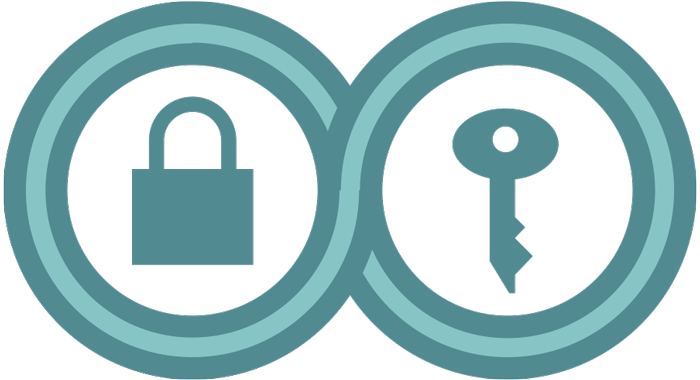How to: Enable Lockdown Mode on iPhone
What Is Lockdown Mode?
Lockdown Mode is an optional setting for iPhone, iPad, and Macs, designed to protect high risk people from specific types of digital threats. It’s available on any device that can run iOS 16, iPadOS 16, macOS 13, and newer.
Malware and spyware developers targeting Apple devices tend to focus on specific weaknesses in the platforms, often ones that manage data sharing, communication tools, or basic file formats. For example, Citizen Lab discovered one exploit that used an Apple Wallet pass and another that targeted HomeKit. Citizen Lab found other similar types of attacks would have likely been thwarted by enabling Lockdown Mode as well.
As with any security software, Lockdown Mode is not perfect protection from every threat all the time, but it has historically proven useful in a number of cases, especially when combined with applying software and security updates.
Lockdown Mode has proven useful for journalists, human rights and democracy activists, and government employees at risk for being spied on through spyware. Despite very little concrete evidence of cell site simulators being used against protesters in the U.S., we think that the steps required to protect yourself are simple enough that it’s a reasonable protective measure for most protesters to take.
Lockdown Mode does not protect you if someone has physical access to your phone. Be sure to use a strong password and passcodes on your devices.
When Lockdown Mode is enabled, your device loses a number of features often targeted by certain types of spyware or other malicious programs. For example, many attachments are blocked in the Messages app, your location is stripped from any photos you share, and incoming FaceTime calls from anyone not in your contacts are blocked.
For some people, enabling Lockdown Mode will significantly change how it feels to use an iPhone or iPad, and may disable certain features you regularly use. There are many small changes that you may not even notice at first, like how Lockdown Mode disables autofill for SMS two-factor authentication codes, while others you will notice immediately, like losing link previews in Messages. Using our “Cover Your Tracks” tool, we also know that a website could see that you’re using Lockdown Mode, which may be an additional fingerprinting metric. Some of these trade-offs will be more difficult than others to make, and whether or not it’s worth it for you depends on your security plan, how you use your device, and what features you rely on.
Pixel phones also have a feature called “Lockdown,” but it doesn’t make the same changes that it does on an Apple device. Instead, it disables biometric device unlocking and requires a PIN or password to unlock your device.
Here are some of the changes you can expect to run into after enabling Lockdown Mode:
App and Web Browsing Changes
- Web browsing: Some web technologies, like just-in-time JavaScript and WebAssembly, are disabled, which can cause issues and make some websites look strange. Web fonts are also disabled, which changes the appearance on many websites and in many apps, and you’ll find that images on some sites may be blocked completely.
- Messages: Most types of message attachments are blocked, except for images, video, and audio. This can disable some major parts of the Messages app, like location sharing and sharing animated GIFs, and it changes what information you can immediately see when sending money in Apple Cash. Link previews are disabled, and you won’t even get a clickable link when someone sends you one, it’s just text that you have to copy and paste into a browser.
- FaceTime: Incoming FaceTime calls are blocked unless the person is in your contacts, or you’ve had a call with them previously. Most extra features, like Live Photos, are disabled.
- Photos: When you share photos, the location information is automatically excluded. Shared Albums no longer work, and new invitations are blocked.
- Some Apple services are disabled: Game Center and invitations to manage a home in the Home app are disabled.
Background Changes
- Configuration profiles can’t be installed: Configuration profiles cannot be installed, nor can your device be enrolled in a new device supervision program while it’s in Lockdown Mode (such as those sometimes required by employers or for school). But if you’ve already installed a configuration profile, then it remains installed.
- Wireless and cellular connectivity changes: 2G cellular support is disabled. Your device also won’t automatically join any non-secure Wi-Fi networks, such as the passwordless networks you may encounter at coffee shops or airports.
How to Enable Lockdown Mode
Enabling Lockdown Mode is not a permanent choice. While it does take some time to turn it on and off because you need to restart your device every time you change the setting, you can do so as many times as you like. This means you can enable Lockdown Mode when you are in a specific situation and then turn it off once you’re safely back home.
Enable Lockdown Mode on an iPhone or iPad:
- Open the Settings app, then Privacy & Security > Lockdown Mode, and tap Turn on Lockdown Mode.
- Tap Turn on & Restart, enter your passcode, and wait for your device to restart.
To disable Lockdown Mode, follow these same directions, but choose “Turn Off Lockdown Mode,” instead.
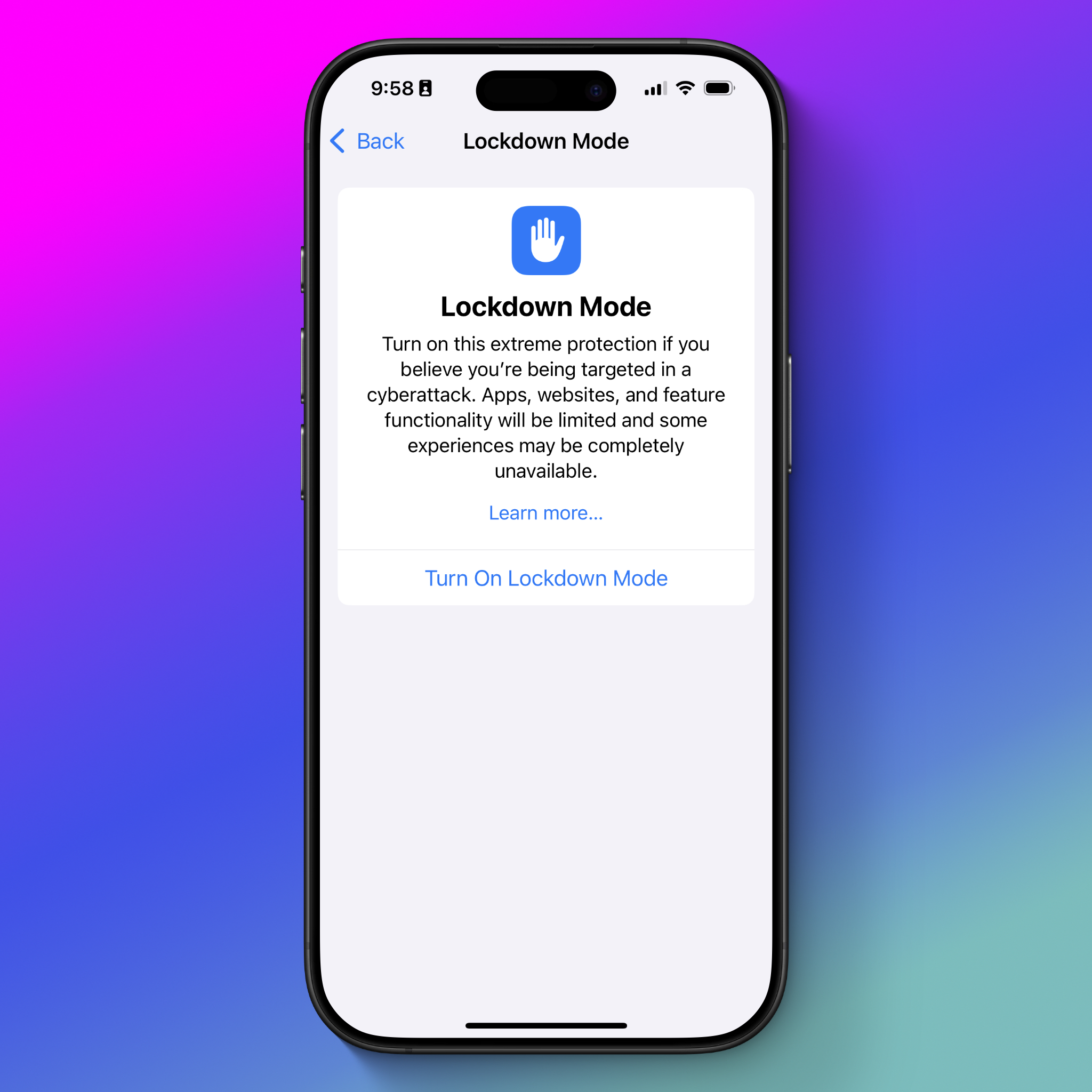
If you have an Apple Watch that’s paired with an iPhone with Lockdown Mode enabled, it will turn on Lockdown Mode on the Apple Watch automatically.
Enable Lockdown Mode on a Mac:
- Open System Settings, then select Privacy & Security from the sidebar.
- Click Lockdown Mode, then Turn On.
- Click Turn On Lockdown Mode and enter your password.
- Click Turn On & Restart, and wait for your computer to reboot.
To disable Lockdown Mode, follow these same directions, but choose “Turn Off Lockdown Mode,” instead.
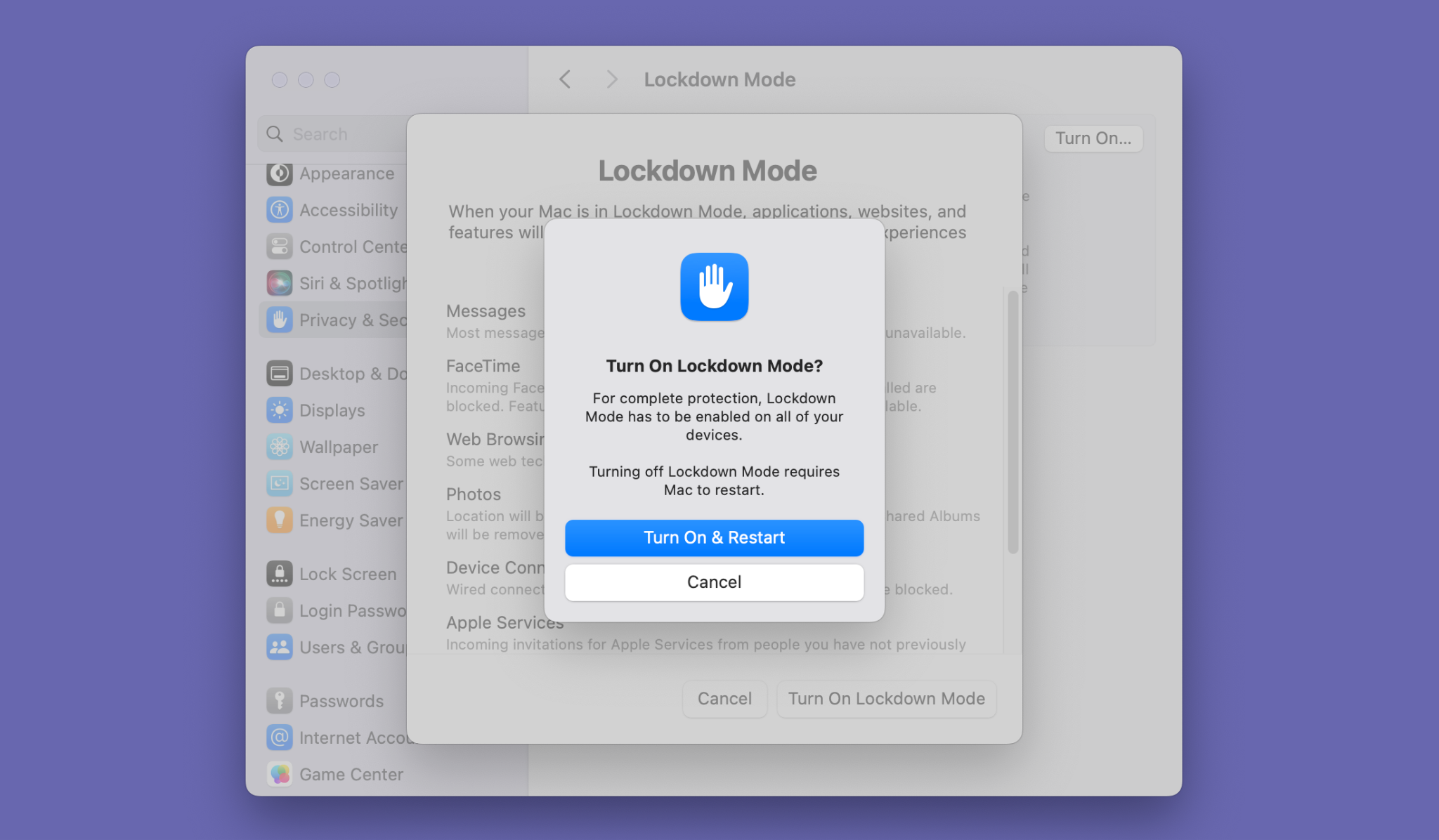
How to Allow Certain Apps or Sites to Work Normally
As mentioned above, Lockdown Mode can break certain websites or apps. In some cases, this is tolerable, like if a website suddenly has a strange font. But in other cases, like a website not displaying images at all, it may make the site impossible to use. You can exempt websites and apps from Lockdown Mode to fix this problem. When doing so, the app or site will work as it would normally, which includes any risks using that app or site may potentially pose.
Before you exempt a site or app, consider the security trade offs: is using this app important enough to justify weakening your overall security?
On iPhone and iPad
If you are having issues with specific apps, you can exclude them from Lockdown Mode.
- Open the Settings app, then Privacy & Security > Lockdown Mode, then scroll down and tap Configure Web Browsing.
- Disable the toggle next to any app you’d like to exempt.
To exclude websites from Lockdown Mode:
- Open up the website in Safari, tap the rectangle tool icon in the left side of the URL bar (or the “Aa” icon, if you’re using iOS 17 or earlier)
- Tap the … icon (or the “Website Settings” option, if you’re using iOS 17 or earlier).
- Scroll down to the Lockdown Mode toggle and disable it. From then on, you will see Lockdown Off for that site in red letters in Safari when you navigate to that website.
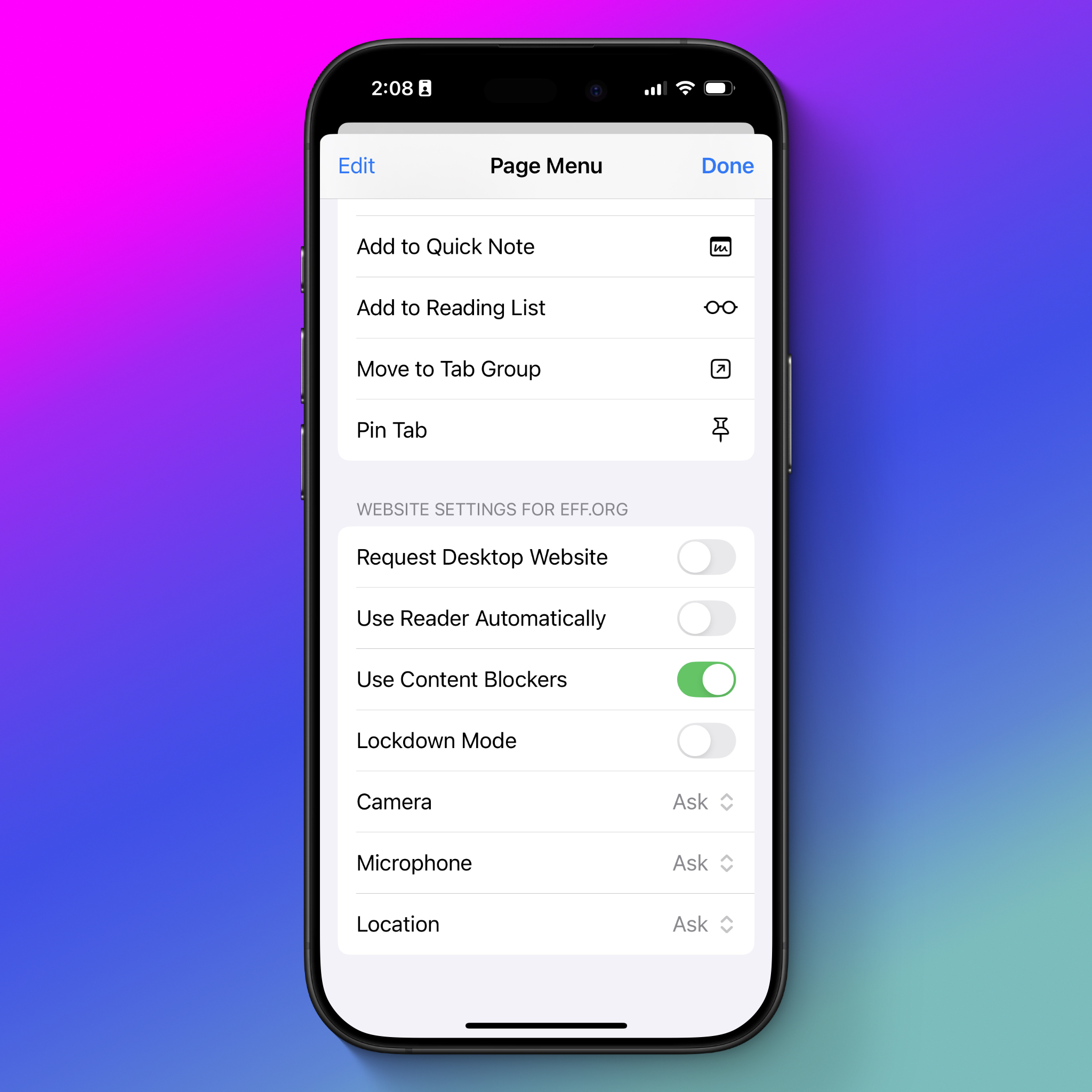
On Mac
When it comes to browsing the web on Mac, you can only exempt sites in Safari. It will not work to protect any browsing done on other browsers, like Chrome or Firefox, nor is there a way to change behavior in apps.
- Head to a website you want to exclude, then click Safari > [name of site] Settings.
- A popup will appear in Safari in the URL bar. Click the box next to Enable Lockdown Mode to disable it for that site.
- You can review which sites you’ve excluded by clicking Safari > Settings > Websites, then scrolling and clicking on “Lockdown Mode.”
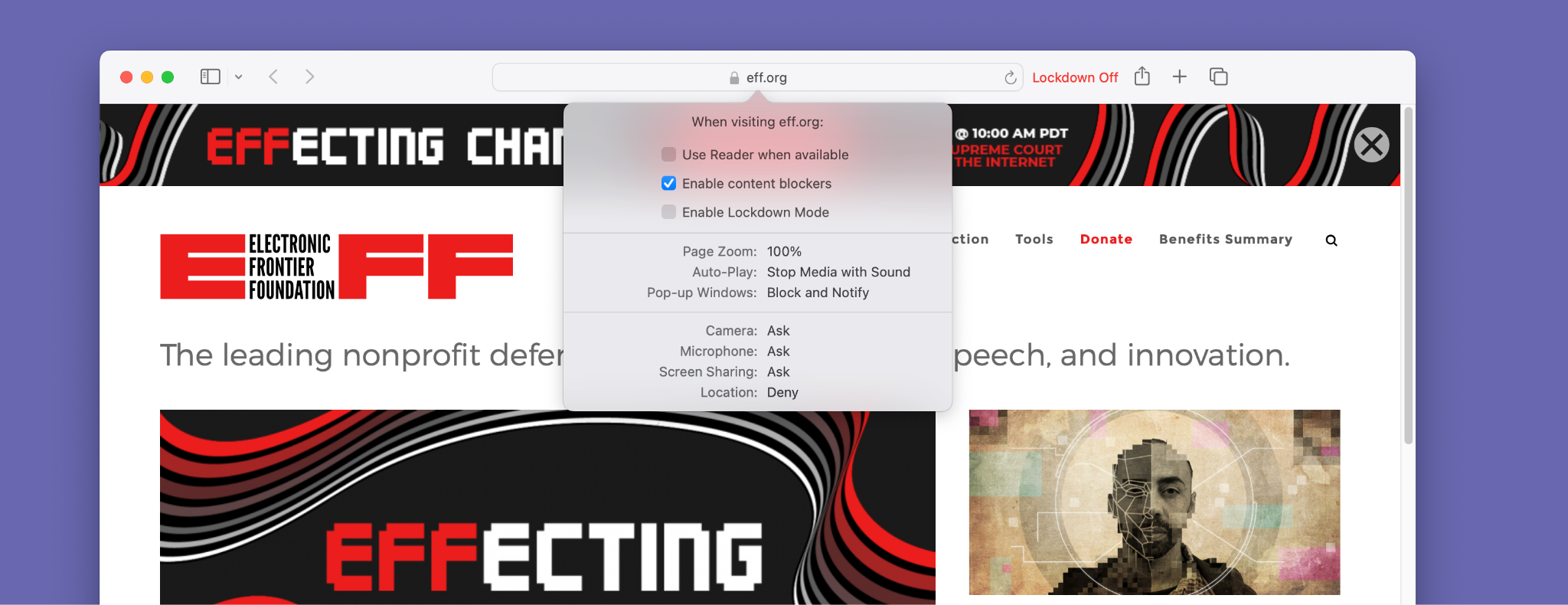
If you own more than one Apple device, you will get prompts to enable Lockdown Mode on other devices once you enable it on one. This is optional, and its usefulness depends on how you use these other devices, and what you use them for.
